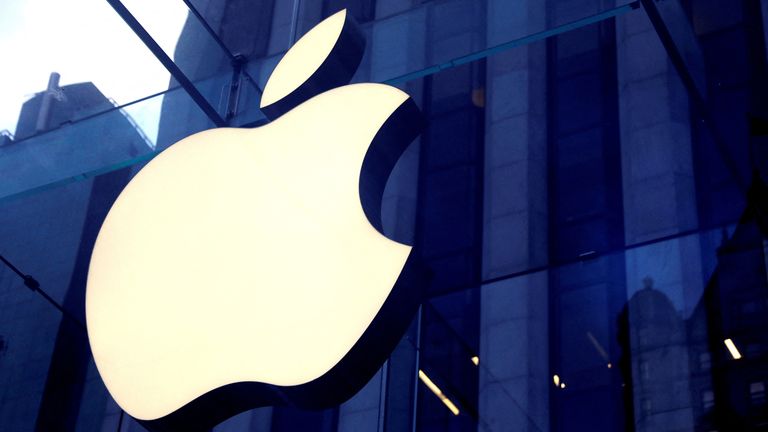At the end of a mixed fortnight’s worth of trading updates from the US tech giants, it was down to the biggest of them – Apple – to lift investor spirits.
The $3.35trn (£2.63trn) giant, established again in June as the world’s biggest company after five months during which Microsoft was bigger, reported sales of $85.78bn (£67.32bn) for the three months to the end of June.
That was up by just under 5% on the same period last year and was also ahead of the $84.53bn (£66.34bn) Wall Street had been expecting.
Money latest – follow for updates
Crucially, iPhone sales, which make up almost half of Apple’s revenues, also came in ahead of expectations, at $39.3bn (£30.84bn).
That was down by 0.9% on the same period last year, but better than the 2.2% decline that had been expected.
That will be seen as quite a resilient showing – it was certainly better than Apple’s own management had expected – in view of the fact that Apple is about to launch the iPhone 16 in September and so some customers will have been holding back from replacing their existing device.
The next version is expected to contain more new features supported by artificial intelligence.
Dan Ives, managing director at Wedbush Securities and one of Wall Street’s best-known tech watchers, has estimated that some 270 million iPhone users have not upgraded their device in the last four years – potentially making this the most important iPhone launch in many years.
Among other stand-outs in the latest numbers was the performance of Apple’s services business, which includes its app store, Apple Pay, Apple Music, iCloud and the Apple TV+ streaming service, which achieved sales of $24.2bn during the quarter – some 15% up on the same period last year.
‘Consistent growth’
Antonio Ernesto Di Giacomo, senior market analyst at the trading platform XS.com, said: “This segment includes services… which have shown consistent growth and have become essential for the company’s revenue diversification.
“The increase in this area reflects Apple’s strategy to expand its service ecosystem and build customer loyalty with an integrated and varied offering.”
Another surprise in the numbers was how well the iPad – sometimes unfairly seen as something of a Cinderella product compared with the flagship iPhone – fared during the quarter.
Sales rose by 24%, to $7.2bn, following new product launches in May.
Blemish
If there was a blemish in the results, it was probably in Greater China, Apple’s third-largest market after the Americas and Europe.
Sales there came in at $14.72bn, down 6% on the same period a year ago, reflecting tough competition from local rival Huawei, whose foldable smartphones and devices have been lapped up by Chinese consumers.
Apple has been forced into offering price cuts in the country to compete with its cheaper rival.
If Apple brought a smile to the faces of tech investors, Amazon did the opposite, with its sales for the quarter coming in below Wall Street expectations for the first time since October 2022.
Shares of Amazon fell by 8% in after-hours trading after sales for the three months to the end of June came in at $147.98bn – which was up 10% on the same period a year ago but $580m lower than Wall Street had been expecting.
Viewed in isolation, the numbers were not too bad, but what appears to have hurt Amazon was that expectations were very high – with the shares having risen by 20% so far this year going into the results.
Accordingly, even though sales at the company’s closely-watched cloud division, Amazon Web Services (AWS), were up 19% to $26.3bn, this was seen as a somewhat lacklustre display compared with rivals.
Slowdown
Microsoft’s Azure platform, for example, reported 29% growth during the quarter on Tuesday evening – although, at the time, that had been seen as disappointing as it represented a slowdown from the 31% growth seen during the previous quarter.
Meanwhile, although sales in Amazon’s core e-commerce business were up – the company’s largest segment, online stores, rose 5% to $55.4bn – this was also seen as somewhat disappointing.
Investors fear the business is facing intensified competition from Chinese competitors such as Shein and Temu.
Also disappointing was the guidance for the next quarter which, again, came in shy of expectations.
AI investment jitters
The crux of the problem for companies like Amazon is that, while they are now investing heavily in AI, investors are becoming increasingly worried about the sums being deployed and focusing increasingly on the returns being generated by that investment in a way they were not just a few months ago.
That was also at the heart of the huge after-hours sell-off in Intel – which saw the chipmaker’s shares fall by 21.5%.
Pat Gelsinger, the chief executive, announced plans to save $10bn through a variety of measures, including scrapping the company’s dividend, slashing investment and cutting Intel’s global workforce by 15%, around 17,500 jobs.
Rivals
Intel has faced tough comparisons with rivals including Nvidia, which is seen as leading the way in AI chips, and with Advanced Micro Devices, to which it has been losing market share in traditional chips.
It all completed a rather mixed reporting season for the tech giants.
Of the so-called “magnificent seven”, Apple, Alphabet and Meta platforms surprised to the upside while Microsoft, Amazon and Tesla proved slightly disappointing.
Attention now returns to Nvidia which publishes its next results – for the quarter to 28 July – on 28 August.
This post appeared first on sky.com










